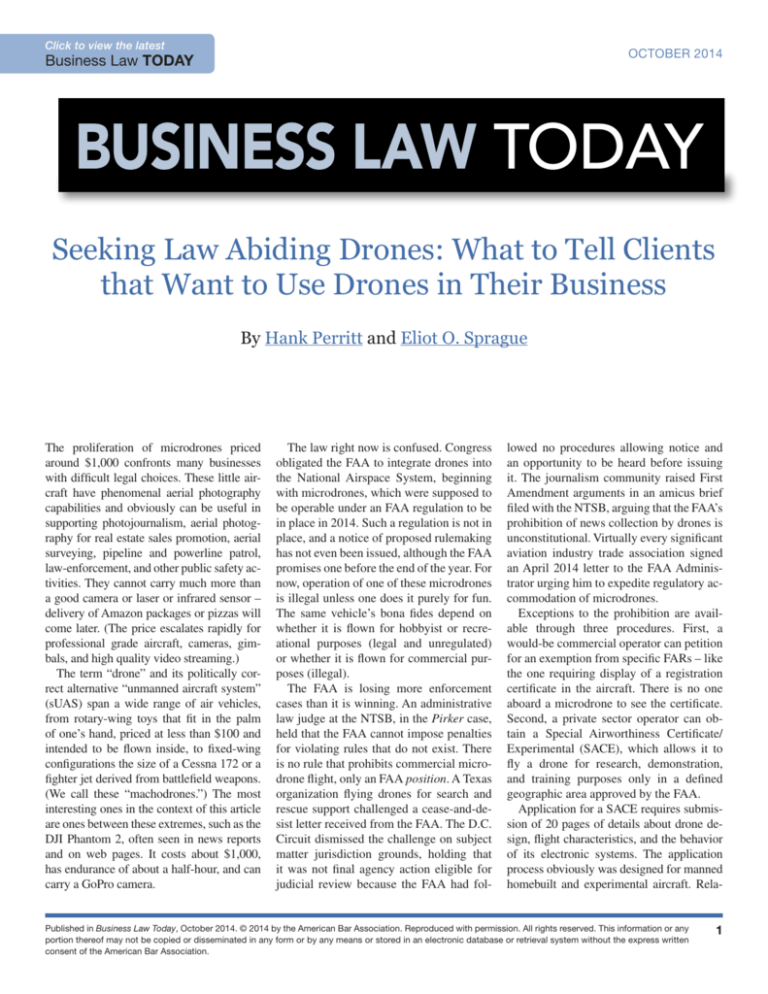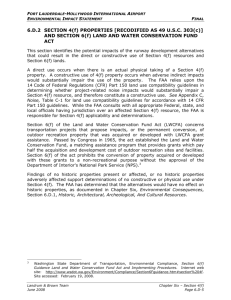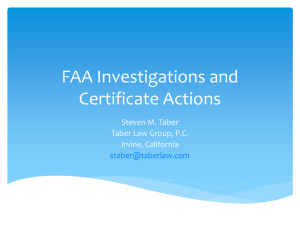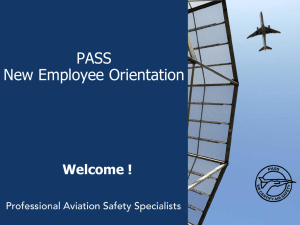
Click to view the latest
October 2014
Business Law TODAY
BUSINESS LAW TODAY
Seeking Law Abiding Drones: What to Tell Clients
that Want to Use Drones in Their Business
By Hank Perritt and Eliot O. Sprague
The proliferation of microdrones priced
around $1,000 confronts many businesses
with difficult legal choices. These little aircraft have phenomenal aerial photography
capabilities and obviously can be useful in
supporting photojournalism, aerial photography for real estate sales promotion, aerial
surveying, pipeline and powerline patrol,
law-enforcement, and other public safety activities. They cannot carry much more than
a good camera or laser or infrared sensor –
delivery of Amazon packages or pizzas will
come later. (The price escalates rapidly for
professional grade aircraft, cameras, gimbals, and high quality video streaming.)
The term “drone” and its politically correct alternative “unmanned aircraft system”
(sUAS) span a wide range of air vehicles,
from rotary-wing toys that fit in the palm
of one’s hand, priced at less than $100 and
intended to be flown inside, to fixed-wing
configurations the size of a Cessna 172 or a
fighter jet derived from battlefield weapons.
(We call these “machodrones.”) The most
interesting ones in the context of this article
are ones between these extremes, such as the
DJI Phantom 2, often seen in news reports
and on web pages. It costs about $1,000,
has endurance of about a half-hour, and can
carry a GoPro camera.
The law right now is confused. Congress
obligated the FAA to integrate drones into
the National Airspace System, beginning
with microdrones, which were supposed to
be operable under an FAA regulation to be
in place in 2014. Such a regulation is not in
place, and a notice of proposed rulemaking
has not even been issued, although the FAA
promises one before the end of the year. For
now, operation of one of these microdrones
is illegal unless one does it purely for fun.
The same vehicle’s bona fides depend on
whether it is flown for hobbyist or recreational purposes (legal and unregulated)
or whether it is flown for commercial purposes (illegal).
The FAA is losing more enforcement
cases than it is winning. An administrative
law judge at the NTSB, in the Pirker case,
held that the FAA cannot impose penalties
for violating rules that do not exist. There
is no rule that prohibits commercial microdrone flight, only an FAA position. A Texas
organization flying drones for search and
rescue support challenged a cease-and-desist letter received from the FAA. The D.C.
Circuit dismissed the challenge on subject
matter jurisdiction grounds, holding that
it was not final agency action eligible for
judicial review because the FAA had fol-
lowed no procedures allowing notice and
an opportunity to be heard before issuing
it. The journalism community raised First
Amendment arguments in an amicus brief
filed with the NTSB, arguing that the FAA’s
prohibition of news collection by drones is
unconstitutional. Virtually every significant
aviation industry trade association signed
an April 2014 letter to the FAA Administrator urging him to expedite regulatory accommodation of microdrones.
Exceptions to the prohibition are available through three procedures. First, a
would-be commercial operator can petition
for an exemption from specific FARs – like
the one requiring display of a registration
certificate in the aircraft. There is no one
aboard a microdrone to see the certificate.
Second, a private sector operator can obtain a Special Airworthiness Certificate/
Experimental (SACE), which allows it to
fly a drone for research, demonstration,
and training purposes only in a defined
geographic area approved by the FAA.
Application for a SACE requires submission of 20 pages of details about drone design, flight characteristics, and the behavior
of its electronic systems. The application
process obviously was designed for manned
homebuilt and experimental aircraft. Rela-
Published in Business Law Today, October 2014. © 2014 by the American Bar Association. Reproduced with permission. All rights reserved. This information or any
portion thereof may not be copied or disseminated in any form or by any means or stored in an electronic database or retrieval system without the express written
consent of the American Bar Association.
1
Click to view the latest
October 2014
Business Law TODAY
tively few SACEs have been granted, mostly
limited to collaborators in six test sites that
the FAA selected in early 2014 to conduct
research into various aspects of drone integration. A handful of others allow larger
fixed-wing drones derived from military designs to be flown in conjunction with oil and
gas exploration in Alaska.
The third route to obtain permission is
to apply for a Certificate of Waiver and
Authorization (COWA), a process still formally available only to governmental entities like the armed services and state and
local law-enforcement agencies. Several
hundred COWAs have been granted, predominantly to the Armed Forces, but also
to some law-enforcement agencies.
The FAA apparently is willing to relax
some of the specific requirements on a
case-by-case basis, but its formal position
is that drones may be operated only under
an exemption, under a SACE or COWA,
that they only may be operated by persons
holding pilot licenses, that drones must be
certificated and registered as aircraft, and
that they must comply with the operating
rules contained in part 91 of the FARs.
Compliance with all of these requirements
is ill-suited to the nature of microdrones
like the Phantom and entirely disproportionate to the risks they present. It is as
though the national Highway Traffic Safety
Administration extended rules designed for
over-the-road trucks to bicycles.
Even if one meets all these requirements,
there is no clear pathway to get approval for
the full range of commercial drone activities.
Apparently the FAA wants to relieve
some of the dammed up pressure for action
in a case-by-case exemption process. The
exemption process is more flexible than
the SACE or COWA processes. It just approved eight Hollywood petitions to allow
microdrone support of movie shooting at
defined locations in California. Still, what
Hollywood proposes to do hardly can be
said to involve integration of drones into
the National Airspace System. It’s more
like enforced segregation.
The FAA has some 40 other petitions
for exemption under consideration, including one filed by co-author Perritt on
behalf of Colin Hinkle, a Chicago news
photographer.
We’ve argued in other articles and in a
petition for rulemaking filed with the FAA
that the agency is thinking about the problem in the wrong way. Microdrones cannot
be regulated as manned aircraft have traditionally been regulated, by trying to specify
the details of drone operation and operator
qualifications; they must be regulated like
the consumer products they are – like lawnmowers – by prohibiting their sale unless
they have built in safety features that cannot be overridden by the DRone OPerator
(DROP). This may help reduce the chance
for midair collisions by reducing temptation to go higher and further.
The FAA should embrace drones’ ability
to hold themselves accountable – to make
them law abiding right out of the box. The
FAA should require them to have built-in
systems to prevent them from violating
fewer than a half-dozen key safety principles. These principles, widely agreed on
as best practices for model aircraft flight:
• restrict flights to the airspace at or below
400 feet above ground level;
• allow flight only within line of sight;
• exclude the drone from those classes of
airspace already defined as controlled and
congested; and
• require the drone automatically to return
to the launching point if something goes
wrong, such as a control-link failure or
operator incapacitation or inattentiveness.
Autonomously implementing these limitations is well within the capability of even
the lowest cost microdrones. Most of them
already have these features, but their activation is optional with the operator. Additional
government regulation is not popular, but
government intervention is the only means
to keep air traffic safely separated. Our proposed approach is far less intrusive than detailed DROP licensing requirements, aircraft
certification, and prescribing and enforcing
flight profiles. It is quite clear that the status
quo is not sustainable. The FAA will never
have sufficient enforcement resources to detect even a fraction of the violations of its
outright ban, let alone to prove those flights
that it detects were for commercial purposes. The thousands of people who think that
flying a Phantom right out-of-the-box from
Amazon would be fun or would be an asset
to their business activities are not going to
wait around for the FAA to navigate its way
out of its regulatory jungle. Unlike traditional manned aircraft pilots and operators, they
have no particular ties to the FAA, have not
been trained in a culture that has the Federal Aviation Regulations at its core, and the
FAA lacks the leverage over them that it has
over pilots commercial aircraft operators,
who must have and maintain some kind of
FAA license or certificate to keep their jobs
and businesses.
The result is that the FAA pretends that
commercial drone flight is illegal while
thousands of people do it anyway, presenting mushrooming hazards to manned
aircraft and to persons or property on the
ground because the operators have not
thought through what the risks are and how
to avoid them.
The regulatory climate is in a state of flux
– to understate the obvious. It will change
week-by-week and month-by-month, and
it will surely open up the possibilities for
much useful commercial drone activity.
Exactly how it will change and what kinds
of trade-off among vehicle design, operator
qualification, and detailed flight rules will
result is difficult to predict.
But many of your clients want to want
to fly them now. Other clients wish drones
could be exterminated.
What do you do?
First, explain to your client the current
distinction between hobbyist and recreational flight on the one hand, and commercial flight on the other. Your client can
do almost anything that qualifies as hobbyist and recreational and, without special
permission, can do almost nothing that involves commercial flight.
Second, make sure your client understands that even small drones can be dangerous. They can collide with manned aircraft, especially if they are flown above 400
feet. (Most manned airplanes and helicop-
Published in Business Law Today, October 2014. © 2014 by the American Bar Association. Reproduced with permission. All rights reserved. This information or any
portion thereof may not be copied or disseminated in any form or by any means or stored in an electronic database or retrieval system without the express written
consent of the American Bar Association.
2
Click to view the latest
October 2014
Business Law TODAY
ters stay above 500 feet, most of the time,
except when they are landing or taking off.)
They can injure persons or property on the
ground if they fly or crash into them. It is
relatively easy for an operator to lose control
of them, especially if they fly too far away
from him or her. The client must understand,
moreover, that it is liable for damage caused
by its drone operations. The general rule is
that standards for common-law negligence
must be based only on FAA regulations.
While state law may provide remedies for
violating the standards; it may not substitute
or supplement the federal standard of care.
But if the FAA has not promulgated regulations for drone operations, the likelihood of
federal preemption is much less.
Third, help your client work through the
risks and rewards of alternative courses of
action. Some clients do not want to be pioneers, testing legal limits. Others are eager to
act, less concerned about legal consequences. The following alternative approaches can
be useful to discuss with clients.
A. Become a test case. Imagine a construction contractor who controls a construction site, secured from public access.
The contractor himself, or through a
drone subcontractor, buys a Phantom
microdrone to obtain overhead photography useful for surveying the site and
monitoring activities to improve it. It
sets the parameters on the Phantom so
that it cannot fly higher than 400 feet
above the ground, so that it cannot fly
outside the boundaries of the construction site, and so that it returns to home if
the control link is lost. This hypothetical
client seeks no advance approval from
FAA; it simply flies its drone to meet
its needs, making sure that all of its employees and contractors comply with the
limitations described.
A similar approach might be suitable
for powerline and pipeline patrol operators and real estate agents who fly only
over property they have legal access to
and a measure of control over.
Bold television stations also can take
advantage of the current legal cloudiness. They have available to them a va-
riety of legal theories that support what
they want to do to distinguish them from
other stations in their markets. They
would go ahead and fly microdrones for
newsgathering, or at least buy newsworthy imagery already collected by somebody else.
This is not as stark a defiance of law
as it might seem. Substantial uncertainty
exists about the validity of the FAA’s prohibition on commercial drone flight. The
Pirker decision has not been reversed
by the NTSB, and it plainly holds the
FAA ban on commercial flight invalid.
The Equusearch decision makes clear
that the FAA must follow due process in
drone enforcement proceedings. And, of
course, a client cited for violating a rule
can defend on the grounds that the rule
is ultra vires or arbitrary and capricious.
The client’s drone activities may go undetected by the FAA, and, even if they
are detected, the FAA may not devote the
resources to an enforcement action.
This is not a risk-free approach, but it
can be useful in crystallizing the legal
framework, if a client is willing to make
itself available as a test case. If the FAA
commences an enforcement action, its
position will be weak, and that of the
client strong.
B. File a petition for exemption. A more
cautious client can file a petition for an
exemption, following in the footsteps
of the Hollywood success and Hinkle’s
effort. They might propose limitations
similar to those proposed in the Hinkle
petition or they might come up with
their own.
C. Get ready. In any event, clients should
get ready to fly their first microdrones
on the first day that FAA rules allowing
commercial use become effective. There
will be a reasonably comprehensive
framework for legal microdrone ENG
flight within the next few years. The
pressure to establish a coherent regulatory framework is simply too strong, and
the mushrooming noncompliance with
the FAA’s ban is changing the political
dynamics and adding the voices of drone
opponents to those of drone proponents
urging the FAA to act soon. Change almost certainly will be in the direction of
permitting commercial drone use; the
statute commands that, and it also clearly
envisions that restrictions will be relaxed
for microdrones before the entire integration problem is solved. As the regulations
are being finalized, it also is not unreasonable to expect that there will be a relaxation for certain kinds of experimental
or demonstration activities in a commercial context through streamlined special
approval mechanisms.
Equipment selection, decisions about
whether to contract for microdrone support or do it in-house, strategies for
deployment and use, development of
downlinks for aerial imagery, training of
field reporters and ENG photographers,
development of legal theories all can be
done now. In fact, Modovolate Aviation,
LLC (“Movo Aviation”) will begin offering packages of ENG microdrones to
local TV stations in early 2015, so that
they can begin preparing.
D. Don’t get caught up in the frenzy over privacy. It is important to keep the privacy
issues in perspective. Lots of privacy law
is on the books already, and privacy advocates are sophisticated and influential.
The FAA knows very little about privacy;
it is a safety agency. Moreover, it is not
clear that the FAA has statutory authority
to promulgate limitations on flight solely
to deal with privacy concerns.
Privacy law already provides basic
protection. If a drone operator causes a
microdrone to look through a bedroom
window and capture imagery of the
people inside, it constitutes common-law
invasion of privacy under the intrusionupon-seclusion variant. If he or she puts
the resulting video up on YouTube, the
operator is liable under the giving-publicity-to-private facts variant. Little case
law exists to support these propositions,
because microdrones having this capability are too new, and it would take an extremely reckless helicopter pilot to commit the tort on the hypothetical facts.
Similarly, tort law also provides protection against aircraft, including drones,
Published in Business Law Today, October 2014. © 2014 by the American Bar Association. Reproduced with permission. All rights reserved. This information or any
portion thereof may not be copied or disseminated in any form or by any means or stored in an electronic database or retrieval system without the express written
consent of the American Bar Association.
3
Click to view the latest
October 2014
Business Law TODAY
flying so low as to constitute a commonlaw trespass or nuisance.
As frequently happens with new technologies, both the benefits and the dangers
of microdrones probably are exaggerated.
As more people buy them and fly them for
commercial purposes, many will discover
that their limited range and endurance and
the fact that they must be transported to the
site by another vehicle blunt their apparent
economic advantages over manned helicopters. Their limitations mean that they
will, at most, supplement manned helicopters, not supplant them.
The dangers also are exaggerated. Few of
them will crash and hurt people or damage
property. Only a few nuts will use them to
peer into bedroom windows, and if the occupants of the bedroom care enough, they
will have a lawsuit strong enough to attract
contingency-fee lawyers.
Meanwhile, the bar should help its clients navigate the regulatory uncertainty,
encouraging the bolder ones to galvanize
some test cases. More important, clients
and the bar alike should help the FAA figure out a viable approach to this new aeronautical opportunity, recognizing the limits
of legal compulsion when the law is too
far out of step with technological reality,
and recognizing that new technologies can
make rules self-enforcing.
Henry H. Perritt, Jr. is Professor
of Law and former Dean, ChicagoKent College of Law, the law school
of Illinois Institute of Technology.
Eliot O. Sprague is a professional
news helicopter pilot, Director of
Business Development for AM Air
Service, a helicopter flight instructor,
and a Member of the Board of
Directors, Midwest Helicopter
Association. The co-authors founded
and own Modovolate Aviation, LLC,
a microdrone contractor (www.
movoaviation.com).
Citations
Colin Hinkle – Exemption/Rulemaking, docket no. FAA-2014-0608,
http://www.regulations.gov/#!docketDetail;D=FAA-2014-0608
Michael P. Huerta v. Raphael Pirker, Docket CP-217
(NTSB ALJ Mar. 6, 2014),
http://www.movoaviation.com/images/PirkerDecision.pdf
Modovolate Aviation, LLC – Exemption/Rulemaking,
docket no. FAA-2014-0473,
http://www.regulations.gov/#!docketDetail;D=FAA-2014-0473
Texas Equusearch Mounted Search and Recovery Team v.
Federal Aviation Administration, No. 14-1061
(D.C. Cir. per curiam order filed July 18, 2014).
* * *
Additional Materials
The co-authors have written a number of articles published in trade magazines
and law reviews and are under contract to write a book about the implications of
inexpensive microdrones. See Henry H. Perritt, Jr. & Eliot O. Sprague, Is there
a drone in your future? Heliweb, May, 2014 p. 14 (with Henry H. Perritt, Jr. &
Eliot O. Sprague); Henry H. Perritt, Jr. & Eliot O. Sprague, Drone Dread, Rotor
& Wing Magazine, June, 2014, p.34; Henry H. Perritt, Jr. & Eliot O. Sprague,
But Who’s Going to Fly Them? Professional Pilot, June, 2014, p.94; Henry
H. Perritt, Jr. & Eliot O. Sprague, Leashing Drones, Rotorcraft Pro, Aug.,
2014; Henry H. Perritt, Jr. & Eliot O. Sprague, Law and Order in the Skies, The
Tech (MIT student newspaper), 13 June 2014; Henry H. Perritt, Jr. & Eliot O.
Sprague, Drones, ___ Vanderbilt J. Ent. & Tech. L. ___ (forthcoming 2014);
Henry H. Perritt, Jr. & Eliot O. Sprague, Ready for the Microdrone Races?, Radio and Television Digital News Association Newsletter (forthcoming,
Oct. 2014); Henry H. Perritt, Jr. & Eliot O. Sprague, Domesticating Drones:
The Technology, Economics, and Law of Unmanned Aircraft (Ashgate,
forthcoming 2015).
Published in Business Law Today, October 2014. © 2014 by the American Bar Association. Reproduced with permission. All rights reserved. This information or any
portion thereof may not be copied or disseminated in any form or by any means or stored in an electronic database or retrieval system without the express written
consent of the American Bar Association.
4





